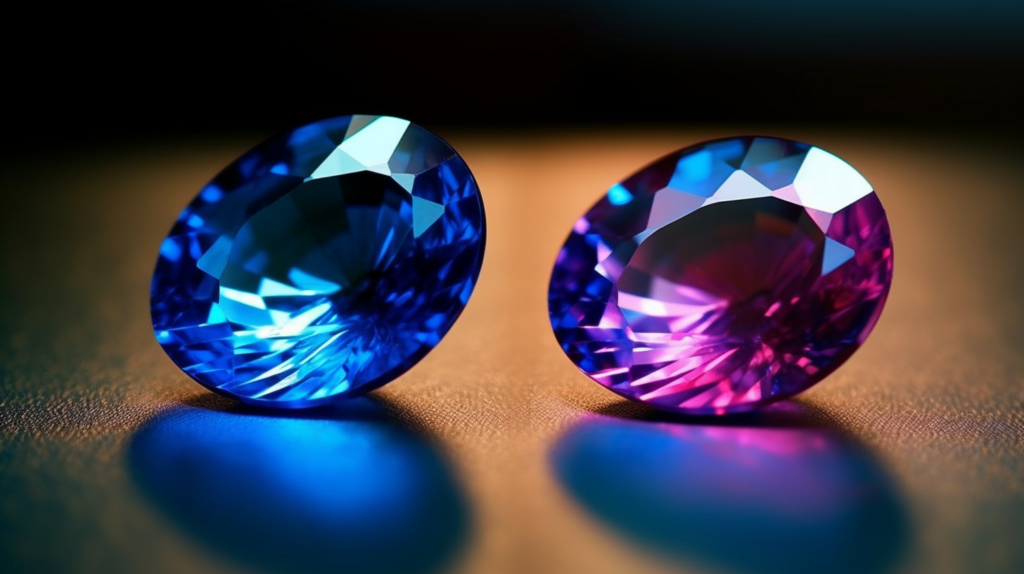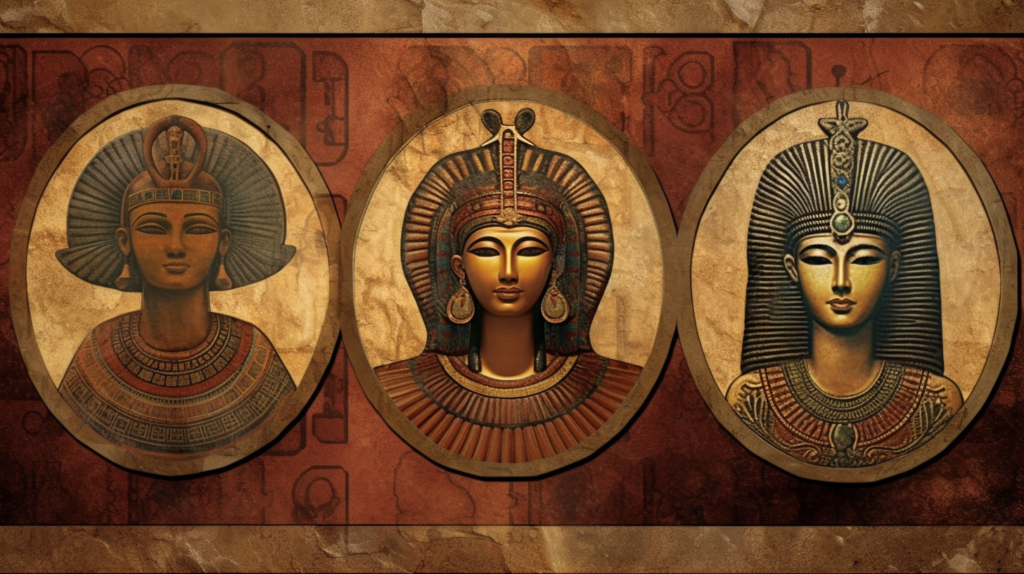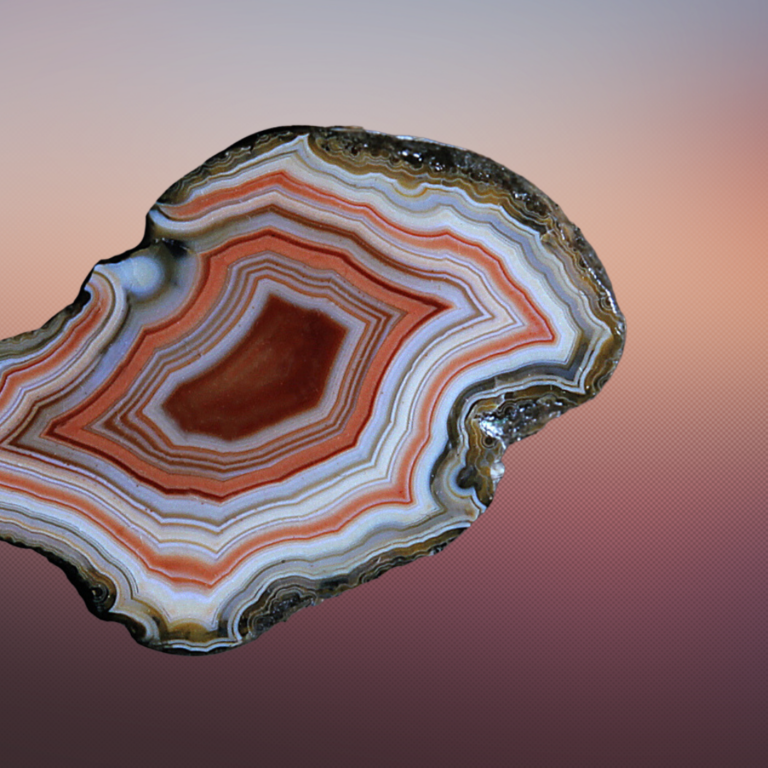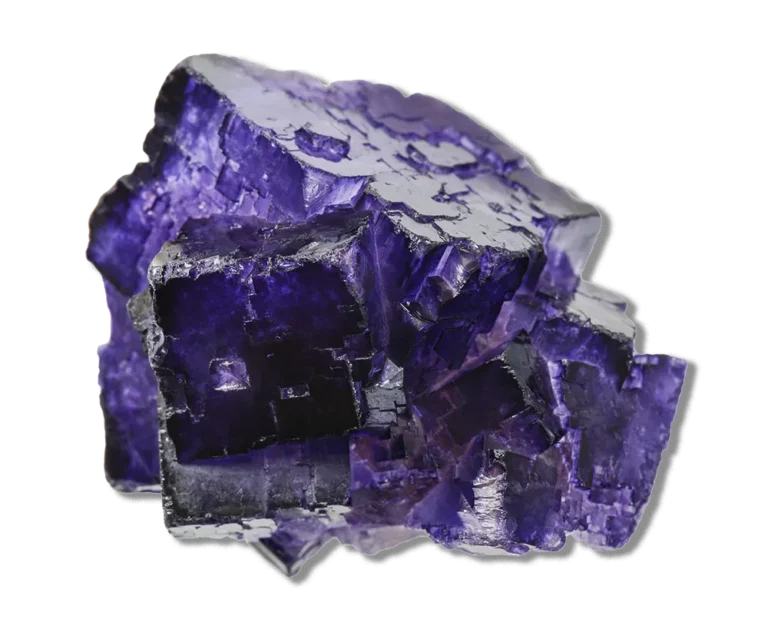Unveiling the Mystique of the Rare Blue Garnet: From Tanzanian Origins to Symbolic Significance
In the realm of precious gemstones, there exists a category of rare treasures that invite intrigue and admiration from the most discerning collectors and enthusiasts. Among these is the elusive Blue Garnet, a gemstone that is as exceptional as it is beautiful.
In This Article
A Glimpse into the World of Blue Garnet

Blue Garnets are not just gemstones; they are a phenomenon that encapsulates the miracles of nature. They belong to the garnet family but are cloaked in an air of exclusivity due to their ability to change color from blue-green in daylight to purplish-red under incandescent light. This color-changing property, combined with their scarcity, makes them highly prized among gem enthusiasts globally.
The first reported discovery of the blue garnet was in the late 1990s in Madagascar. Since then, blue garnets have been found in several other locations, including Tanzania, Sri Lanka, and the United States, with the finest specimens heralding from the Umba River Valley in Tanzania.
Unveiling the Rarity: The Collectable Blue Garnet
While garnets in general are fairly common, the blue garnet is a rare find. This rarity stems from its unique chemical composition, which includes the presence of vanadium, a mineral not usually found in garnets. This mix of minerals, paired with the precise geological conditions necessary for their formation, makes the discovery of blue garnets an uncommon event.
Moreover, the blue garnet is adored for its unique hue. The cool, soothing blue hint that touches the deep red gemstone is a refreshing divergence from the warm shades commonly associated with garnets. This distinct color and the rarity of its occurrence make the blue garnet a highly sought-after addition to any collection, a gem that symbolizes both rarity and beauty.
With its tantalizing color-changing properties and limited availability, the blue garnet has carved a niche for itself in the world of gemstones. Join us as we delve deeper into the origins, formation, and significance of this fascinating gemstone, providing a comprehensive guide for both seasoned collectors and budding gem enthusiasts alike.
Geological Formation and Characteristics of Blue Garnet

To understand the allure of the Blue Garnet, one must delve into the intricate processes that give birth to this dazzling gemstone. They are a testament to the wonders of natural geology and a memento of the Earth’s vibrant history.
The Unique Composition of Blue Garnet
Garnets are a group of silicate minerals that have been used since the Bronze Age as gemstones and abrasives. However, not all garnets are created equal. The formation of the blue garnet is a complex process that involves specific geological conditions.
Most garnets are red or orange in color due to the presence of iron or manganese. However, blue garnets are different. Their unique color change attribute is due to the presence of vanadium or chromium, which are not commonly found in other garnets.
When these elements are present in the right quantities, and under the right conditions of pressure and temperature, they combine to form a garnet of stunning beauty. The blue or green color seen in daylight changes to a purplish-red or pink under incandescent light, offering a delightful visual feast for the eyes.
The Tanzanian Blue Garnet: Gems from Umba River Valley
While blue garnets can be found in a few places across the globe, the Umba River Valley in Tanzania is renowned for producing some of the finest blue garnets. This region provides the perfect geological conditions for the formation of these gems.
The Umba River Valley isn’t just the birthplace of blue garnets, it’s also the site of a fascinating geological puzzle. The region’s complex geological history, involving changes in rock types and shifts in tectonic plates over millions of years, has resulted in a rich and diverse array of gemstones, including spectacular blue garnets.
These gemstones are extracted from alluvial deposits. The painstaking process of extraction is often carried out by locals using simple tools, reflecting a way of life that has been preserved for centuries. This not only adds to the allure of the gemstones but also makes each blue garnet a piece of Tanzanian heritage, encapsulating the story of its land and people.
This section provides a glimpse into the birth and nature of the blue garnet. However, the charm of this gemstone does not stop at its formation. We will now explore its magical color-change phenomenon and delve into the cultures and symbolism that it carries.
The Magic of Color Change

Blue Garnets are known for one seemingly magical property: their ability to change color based on the lighting conditions. This phenomenon is not only mesmerizing but also adds to the rarity and desirability of these gemstones.
The Phenomenon of Color Change in Umbalite Garnet
The color change in blue garnets, also known as Umbalite Garnets, is a result of the gemstone’s unique composition and the way it interacts with different light sources.
Under natural or fluorescent light, a blue garnet often projects a stunning blue or green hue. However, under incandescent or candle light, the same gemstone can show a purplish-red or pink color. This is due to the presence of different chromophores in the gemstone, which absorb light in different ways.
The phenomenon of color change in gemstones is not limited to garnets. Other gemstones like Alexandrite and some sapphires also exhibit this whimsical trait. However, the extent of color change and the specific colors exhibited are unique to each gemstone and each individual stone, making each blue garnet truly unique.
Vanadium: The Secret Behind the Color Change
The secret behind the striking color change in blue garnets lies in the presence of a trace element called vanadium. Vanadium ions in the crystal structure of these garnets are believed to be responsible for their color-changing ability.
When light strikes a blue garnet, the vanadium ions absorb certain wavelengths. Under daylight or fluorescent light, the blue or green wavelengths are reflected back, giving the gem its blue-green color. However, under incandescent light or candlelight, which have a wider range of wavelengths, the blue garnet reflects back a purplish-red color.
The color-changing property of blue garnets adds an additional layer of depth and intrigue to these gemstones, contributing to their status as one of the most coveted gems in the world. The magic of color change is just one facet of the blue garnet’s allure. As we delve deeper, we’ll explore the historical significance and cultural symbolism of these gems.
Historical Significance and Cultural Symbolism of Garnets

Garnets are among some of the oldest known gemstones with a history that spans thousands of years. Their significance, however, extends beyond their geological and aesthetic allure, touching realms of culture, history, and symbolism.
Garnets: A Journey Through Time
Garnets have been treasured for millennia. Archaeological findings reveal their use as decorative artifacts and talismans in ancient Egypt, Greece, and Rome. They were particularly revered in the Middle Ages and Renaissance periods, often symbolizing royalty and high society.
However, blue garnets’ more recent discovery in the late 20th century means their historical significance is still unfolding. They have quickly become some of the most prized gems for modern collectors, given their rarity and intriguing color-changing characteristics.
Symbolic Representations of Garnets in Cultures Across the Globe
Globally, garnets have been bestowed with a multitude of meanings and symbolic representations. They are often associated with protection, healing, and strength.
In the realm of spiritual symbolism, garnets are believed to induce passion, commitment, devotion, and trust. They are often associated with love and relationships, with some cultures believing that garnets can rekindle old friendships, mend broken bonds, and inspire new love.
Blue garnets, with their rare color-change feature, are often seen as symbols of adaptability and transformation, embodying change and versatility. Their blue-green hue may invoke feelings of tranquility and peace, while their purplish-red shade under incandescent light can symbolize passion and intensity.
The historical significance and cultural symbolism of garnets add another dimension to their allure, painting a picture of a gemstone deeply intertwined with the human experience. As we progress, we’ll compare the blue garnet to other blue gemstones and explore the challenges involved in sourcing and acquiring this elusive gem.
Blue Garnet and Other Blue Gemstones
While there’s certainly no shortage of blue gemstones in the market, few can match the unique charm of blue garnet. Its capacity to transform colors and its rarity set it apart in the world of gemstones.
The Queensland Teal Sapphire Vs. The Tanzanian Blue Garnet
The Queensland Teal Sapphire, another gemstone known for its captivating blue hue, shares some similarities with the Tanzanian Blue Garnet. Both gems are renowned for their stunning colors and are sourced from locations known for abundant gemstone deposits – Queensland in Australia and the Umba River Valley in Tanzania.
However, this is where the similarities end. Unlike the blue garnet, teal sapphires do not change color under different light sources. Furthermore, while sapphires are second only to diamonds in terms of hardness, garnets are comparatively softer, contributing to their different applications and care requirements.
How the Unique Color Change Sets Blue Garnet Apart
Arguably the most defining characteristic that separates blue garnet from other blue gemstones is its rare ability to change color. This chameleon-like quality, coupled with its scarcity, makes it a prized possession for collectors around the world.
While some gemstones like Alexandrite also exhibit this trait, the color change in blue garnet, shifting from cool blue-green in daylight to purplish-red under incandescent light, is unique. This transformation provides a sense of mystique and allure that adds to the gemstone’s value and appeal.
The exploration of blue garnets within the wider context of blue gemstones serves to underscore their exceptional nature. However, acquiring these gemstones poses its own challenges. In the next section, we delve into the complexities of sourcing and purchasing blue garnets.
Sourcing and Acquiring Blue Garnet: A Daunting Task
The allure of blue garnet is undeniable, but acquiring one isn’t as straightforward. The rarity and exclusivity of this gemstone make sourcing and procurement a challenging task, even for seasoned gemstone buyers.
The Challenges in Sourcing Blue Garnet
In the gemstone industry, challenges abound in sourcing blue garnet. These gemstones are exceedingly rare, making their discovery sporadic and often limited to specific locations, such as the renowned Umba River Valley in Tanzania.
Additionally, mining operations are usually small-scale, sometimes involving local communities using basic extraction methods. This lack of industrialization, while preserving the local way of life, slows down production and contributes to the scarcity of blue garnets in the market.
Furthermore, blue garnets, like all garnets, are not sorted and categorized by a universal standard grading system as diamonds are. This means determination of quality relies heavily on the experience and expertise of the buyer, adding another layer of complexity to the sourcing process.
Why Acquiring Calibrated Blue Garnet is a Tough Job
Calibrated gemstones are cut to standardized dimensions to fit into pre-made jewelry settings. These are popular in the jewelry industry due to the convenience they offer. However, obtaining calibrated blue garnets is a particularly tough job.
Firstly, their rarity simply means there are fewer blue garnets available to be cut to specific dimensions. Secondly, the aim to preserve as much of the gemstone’s weight as possible during cutting often takes precedence over achieving calibration due to the high value of the rough material.
In effect, each blue garnet is a unique piece, individually cut, and carries its own distinct value and allure.
Sourcing and acquiring blue garnet may be a daunting task, but the thrill of the chase and the joy of ownership underpin its appeal. Next, we delve into the techniques used to bring out the true beauty of blue garnet and its applications in jewelry and beyond.
Lapidary Techniques and the Brilliance of Blue Garnet
The journey of a blue garnet from being a rough stone to a dazzling gem is an art form that requires an astute understanding of the gem’s properties and masterful craftsmanship.
Enhancing the Beauty of Blue Garnet: Lapidary Techniques
Lapidary, the art of cutting, shaping, and polishing stones, is vital in transforming the raw blue garnet into a gem that’s ready for setting into jewelry. Skilled lapidaries use a variety of techniques, such as faceting, to enhance the gemstone’s color, maximize its brilliance, and minimize the visibility of any inclusions.
Given the rarity of blue garnet, the goal is often to retain as much of the gemstone’s weight as possible. This factor heavily influences the decision-making process during cutting. Therefore, each blue garnet is typically custom cut, resulting in a wide variety of shapes and sizes.
From Rough Stone to Dazzling Gem: The Transformation of Blue Garnet
The transformation of a rough blue garnet into a polished gemstone is a meticulous process. The lapidary must study the rough material carefully to decide on the optimal cut that will bring out the gemstone’s best features.
Once the ideal cut has been chosen, the lapidary uses precise tools to cut the rough gemstone, facet by facet, into the desired shape. The gemstone is then polished to enhance its luster, completing the transformation from a rough stone to a dazzling gem.
This detailed process not only brings out the inherent beauty of the blue garnet but also helps to showcase its unique color-changing property. Each finished blue garnet is a testament to the lapidary’s skill and the gemstone’s innate charm.
The journey of a blue garnet, from its geological formation to its transformation through lapidary techniques, underscores its allure. In the next section, we explore how this gemstone’s versatility extends its use beyond traditional jewelry.
Blue Garnet in Jewelry and Beyond

While blue garnets are most commonly used in jewelry, their unique properties and allure open up possibilities for their use in diverse applications.
The Versatility of Blue Garnet in Jewelry
Blue garnet’s stunning color change, along with its fascinating history and rarity, makes it an alluring choice for jewelry. From rings and necklaces to earrings and bracelets, blue garnet can add an intriguing twist to any piece.
Given its relatively softer nature compared to gemstones like diamonds and sapphires, blue garnet is often set into pieces of jewelry that are less likely to experience rough wear, like pendants and earrings. However, with the right setting and care, it can be used in any form of jewelry, providing a captivating focal point that constantly changes with the light.
Potential Applications of Blue Garnet Beyond Jewelry
While the most common application of blue garnet is in jewelry, its potential extends beyond this realm. Given its scarcity and unique properties, blue garnet has become a symbol of luxury and exclusivity, making it a popular choice for high-end collectibles and statement pieces.
Furthermore, the symbolism associated with garnets—such as passion, transformation, and healing—make them interesting candidates for use in holistic and alternative therapies. Some believe that garnets can be used to promote emotional healing and spiritual growth.
Moreover, the technical aspects of blue garnet’s color change properties may also hold potential for future applications in industries such as optics and materials science, although such usages are currently purely speculative and require further research.
From adorning one’s body as jewelry to being a spiritual guide or a symbol of luxury, the blue garnet is a gemstone that goes beyond the ordinary. In the next section, we delve into caring for this gemstone and its durability.
Blue Garnet Care and Durability
Like all gemstones, blue garnets require thoughtful care to maintain their beauty and integrity over time. Understanding their durability and the best methods for cleaning and storing them can prolong their lifespan.
How to Take Care of Your Blue Garnet
Despite their magnificence, blue garnets are not as hard as diamonds or sapphires. Their hardness ranks 6.5 to 7.5 on the Mohs scale of mineral hardness, which makes them susceptible to scratches and abrasions if not handled with care.
Due to the color change phenomenon, it’s best to clean blue garnets using warm soapy water and a soft cloth or toothbrush to maintain their luster. Harsh chemicals and ultrasonic cleaning methods should be avoided as they can damage the gemstone.
When it comes to storing your blue garnet, keep it separate from other gemstones to prevent scratches. A fabric-lined jewelry box or a soft pouch would make for an ideal storage space.
Understanding the Durability of Blue Garnet: The Mohs Scale
The Mohs Scale of Mineral Hardness is commonly used to determine a gemstone’s hardness and, thus, its resistance to scratches. Ranking at 6.5 to 7.5, blue garnets are moderately hard, but they are not as resistant to scratches as gemstones with higher rankings like diamonds or sapphires.
However, with proper care and handling, blue garnets can still be enjoyed for a lifetime. Their durability, combined with their unique color change property, makes them a fascinating addition to any jewelry collection.
Caring for a blue garnet isn’t just about preserving its physical beauty, it’s also about cherishing its rarity and the magic it embodies. In the final section, we explore Blue Garnet Consulting, a firm that, like the gemstone, is dedicated to creating significant and transformative change.
Blue Garnet Consulting: Strategy and Management for Social Impact
Beyond the world of gemstones, the name Blue Garnet also represents a consultancy firm that, much like the transformative properties of the blue garnet gemstone, strives to generate meaningful change and create a lasting impact.
An Introduction to Blue Garnet Consulting
Blue Garnet Consulting is a Los Angeles-based firm that works with social-impact organizations to develop strategies, build capacities, and design learning systems that facilitate effective decision-making and sustainable change. The firm mirrors the unique and transformative characteristics of its namesake gemstone, aiming to create value and catalyze change in the social sector.
The Role of Blue Garnet Consulting Within the Social Impact Ecosystem
Blue Garnet Consulting operates within the social impact ecosystem, engaging with nonprofits, philanthropists, social enterprises, and corporate citizenship organizations. They work hand-in-hand with leaders and teams to navigate complex social issues, design effective strategies, and measure their impact.
By harnessing the versatile properties of the blue garnet as a symbol of transformation, adaptability, and durability, the consultancy firm seeks to create lasting social change that aligns with their clients’ mission and values.
Measuring Outcomes: The Impact of Blue Garnet Consulting on Clients and Projects
Much like the value of the blue garnet gemstone is determined by its rarity and distinctive attributes, the value of Blue Garnet Consulting is measured by the impact it generates. Through their work, they aim to create substantial, sustainable changes that resonate with their clients’ objectives, stakeholders, and the communities they serve.
In the same way that each blue garnet gemstone tells a story of its journey, Blue Garnet Consulting contributes to the narratives of social change, creating a lasting impact in the sector.
In our concluding section, we will draw together the various threads of the blue garnet story, tying the physical gemstone and its symbolic representations back to the core allure of this exceptional gem.
Final Thoughts: Embracing the Mystique of Blue Garnet
As we reach the end of our exploration into the captivating world of blue garnet, it’s important to remember the multifaceted nature of this gemstone. From its natural history to its symbolic significances, the blue garnet is more than just a gem.
The Enduring Allure of the Rare Blue Garnet
Blue garnet’s allure lies in its rarity and its distinctive color change ability. It’s a gemstone that mesmerizes not only with its physical beauty, but also with the narratives it carries: narratives of geological marvel, human craftsmanship, and symbolic potency. Whether set into a piece of jewelry or held in a collector’s hand, it exudes a charm that commands attention and respect.
The Blue Garnet Experience: A Gemstone Like No Other
Experiencing a blue garnet is truly like no other. Holding a piece of blue garnet is not just about owning a rare gemstone – it’s about embracing its story, respecting its journey, and appreciating the forces of nature that brought it into existence. It’s about acknowledging its transformative power, reflected in the magical color change and the symbolism it carries.
In the world of gemstones, the blue garnet’s rare existence, coupled with its unique physical and symbolic attributes, marks it as a gemstone like no other. It stands resolute, sharing its light and transforming with the world around it, much like the action of the consultancy firm that shares its name.
From geological formations to cultural representations, lapidary techniques to consulting strategies, the story of the blue garnet is as unique and captivating as the gemstone itself. As we conclude, the true mystique of the blue garnet is unveiled: it’s not just a gemstone, but a testament to the captivating narratives of our world.
Frequently Asked Questions (FAQs)
What are the unique properties of the Blue Garnet?
Blue Garnet is a rare gemstone known for its unique color change phenomenon, driven by the presence of Vanadium. Its composition and geological formation also make it special. These factors combined make it a collectable item and a gemstone like no other.
Where is Blue Garnet typically sourced from?
The Tanzanian Blue Garnet in particular is sourced from the Umba River Valley. However, sourcing and acquiring Blue Garnet is a challenging task due to the stone’s rarity and the difficulty in obtaining calibrated stones.
How is Blue Garnet used in jewelry and other applications?
Blue Garnet is a versatile gemstone that is commonly used in jewelry. Its unique color and brilliance, especially after undergoing lapidary techniques, makes it a beautiful addition to any piece. Beyond jewelry, there are potential applications for Blue Garnet in various fields, although these are not widely explored yet.
What is the significance and symbolism of Garnets in history and culture?
Garnets have a rich historical significance and have symbolic representations in cultures across the globe. They are revered for their beauty and mystical properties, enhancing their value and allure.
How does Blue Garnet Consulting contribute to social impact?
Blue Garnet Consulting operates within the social impact ecosystem, providing strategies and management solutions designed to maximize impact. They play a significant role in measuring outcomes and improving the effectiveness of clients’ social impact projects.







